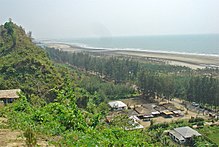Cololejeunea chittagongensis
| Cololejeunea chittagongensis | ||||||||||||
|---|---|---|---|---|---|---|---|---|---|---|---|---|

Holotype of Cololejeunea chittagongensis in the Muséum national d'histoire naturelle , Paris |
||||||||||||
| Systematics | ||||||||||||
|
||||||||||||
| Scientific name | ||||||||||||
| Cololejeunea chittagongensis | ||||||||||||
| P.Tx. |
Cololejeunea chittagongensis is a liverwort species from the Lejeuneaceae family . The species is endemic to western Southeast Asia and is only known from localities in the Chittagong division in Bangladesh , where itliveson the bark of deciduous trees .
features
Cololejeunea chittagongensis makes pale green to light green depressed lawns on tree bark. The individual plants are small, the stems are about five millimeters long and about 50 micrometers in diameter. They carry 1.2 millimeter long overshot and double-lobed flank leaves that are at an angle of 90 ° to the stem and are 0.5 millimeters apart. The oval, smooth and rimless upper lobes do not cover the stalk, they are 0.5-0.6 millimeters long and 0.4 millimeters wide. The lower leaves are more or less parallel to the stem, they are only 0.8 millimeters long and 0.15 millimeters wide. The thin-walled marginal leaf cells are 15 to 20 by 10 to 15 micrometers in size, the basal ones are 30 to 40 by 15 to 20 micrometers in size. The hairy stalks have four cells, at their tips are colorless, translucent, spherical papillae with a diameter of 0.15 micrometers.
The plants are diocesan . The archegonium has an egg cell and unequal bilobed bracts 0.3 millimeters long and 0.15 millimeters wide and 0.2 millimeters long and 0.10 millimeters wide. The perianthia are obovoid (inverted ovoid) with ventral folds and a rounded tip, they are 0.6 millimeters long and 0.4 millimeters wide.
Location requirements
Cololejeunea chittagongensis is only known from the bark of deciduous trees.
distribution

In the first description is as locus classicus denatured Küstenwald in the district of Cox's Bazaar ( 21 ° 25 '0 " N , 91 ° 59' 0" O ), Division Chittagong indicated in the Cololejeunea chittagongensis on March 10, 1965 in five meters the sea level was found on tree bark. The species is endemic to western Southeast Asia ( l'Indochine occidentale ), whose western border is traditionally the Ganges .
The index card for the holotype contains different information. Accordingly, the holotype was collected on March 1, 1985 in Kaptai ( 22 ° 30 ′ 0 ″ N , 92 ° 13 ′ 0 ″ E ) at a height of 20 meters above sea level. Kaptai is an Upazila in the Rangamati District in the Chittagong Division, it is known for the Karnaphulistausee (English: Kaptai Lake ). The exact location given was the bank of the Karnaphuli , where Cololejeunea chittagongensis was found on branches.
Systematics
The Lejeuneaceae family is the most extensive family of liverworts and the class Jungermanniopsida with more than 1000 species in more than 90 genera . In it, Cololejeunea is the sister taxon to Aphanolejeunea and by far the most extensive genus. Due to the often only minor morphological differences and the great intraspecific variability, the genus, like the whole family, is taxonomically difficult to process.
Due to the clear differences to the other species of the genus Cololejeunea , Pierre Tixier presented the monotypical section Pseudochlorolejeunea P.Tx. with the type species Cololejeunea chittagongensis P.Tx. on. This section was placed in the subgenus Pedinolejeunea. Recent research has led to the finding that the subgenera and sections of Cololejeuna are to a large extent paraphyletic .
The holotype and another type specimen of Cololejeunea chittagongensis were initially included in Pierre Tixier's personal collection. Today they are in the collection of the Muséum national d'histoire naturelle in Paris. The holotype is accompanied by a note with which the Chinese lichenologist Rui-Liang Zhu indicated by hand in July 2002 that this specimen is Cololejeunea raduliloba Steph. acts. The second type specimen is accompanied by an index card which, including the number in Tixier's collection, bears information identical to the holotype.
The species name chittagongensis refers to the city of Chittagong , the capital of the district of the same name and the Chittagong division.
literature
- Pierre Tixier: Contribution à la Connaissance des Cololejeunoideae (= Bryophytorum Bibliotheca, Volume 27) . Vaduz, Cramer 1985, pp. 97–98, ISBN 3-7682-1418-4 (first description, in Latin and French).
Individual evidence
- ↑ a b c d Pierre Tixier: Contribution à la Connaissance des Cololejeunoideae , pp. 97–98.
- ↑ a b Cololejeunea chittagongensis Tixier , website of the Muséum national d'histoire naturelle , accessed on May 9, 2019.
- ^ S. Robbert Gradstein, M. Elena Reiner-Drehwald and Harald Schneider: A phylogenetic analysis of the genera of Lejeuneaceae (Hepaticae) . In: Botanical Journal of the Linnean Society 2003, Volume 143, No. 4, pp. 391-410, doi: 10.1111 / j.1095-8339.2003.00235.x .
- ↑ Ying Yu et al .: Evidence for Rampant Homoplasy in the Phylogeny of the Epiphyllous Liverwort Genus Cololejeunea (Lejeuneaceae) . In: Systematic Botany , Volume 38, No. 3, pp. 553-563, doi: 10.1600 / 036364413X670304 .

